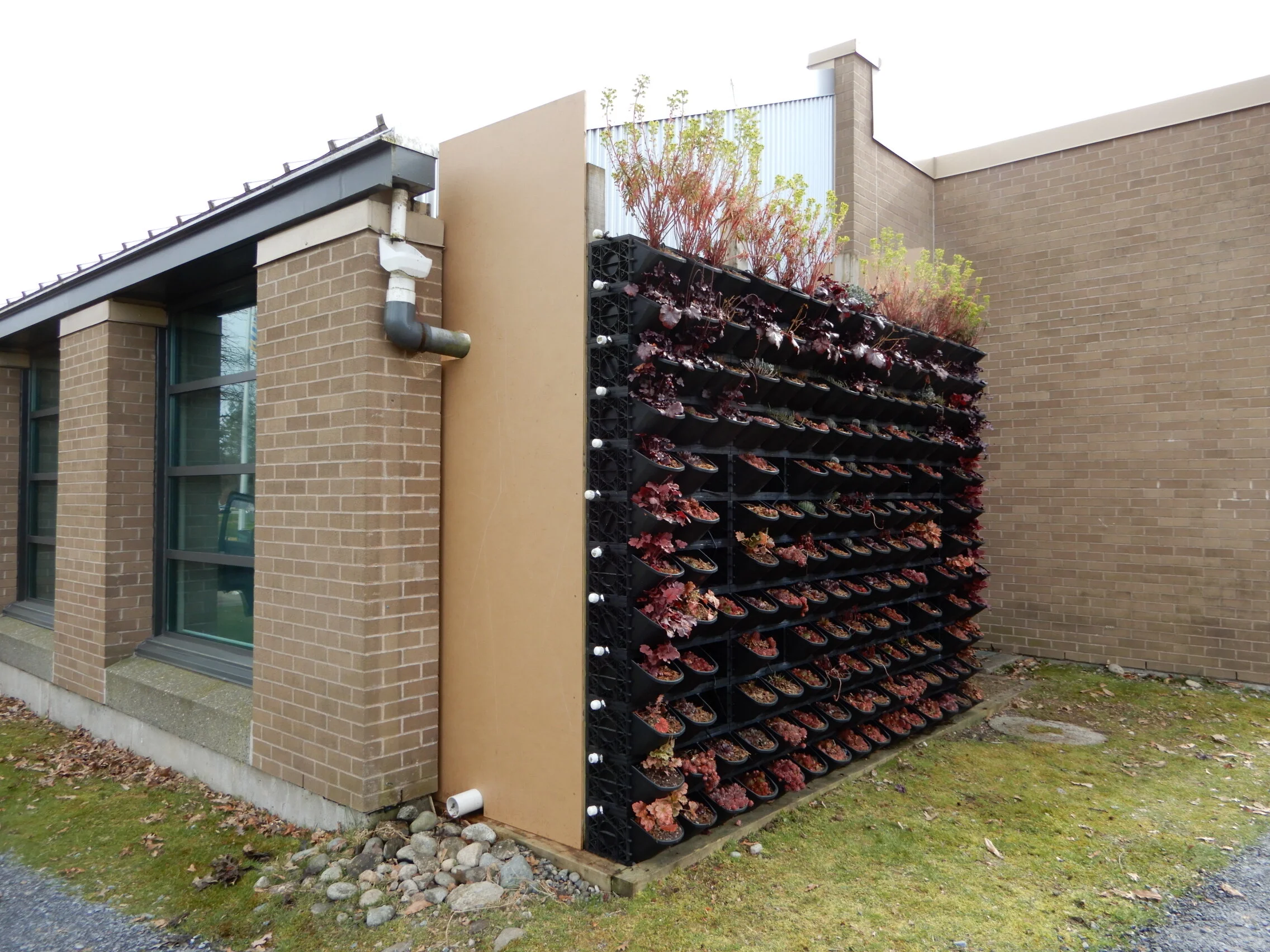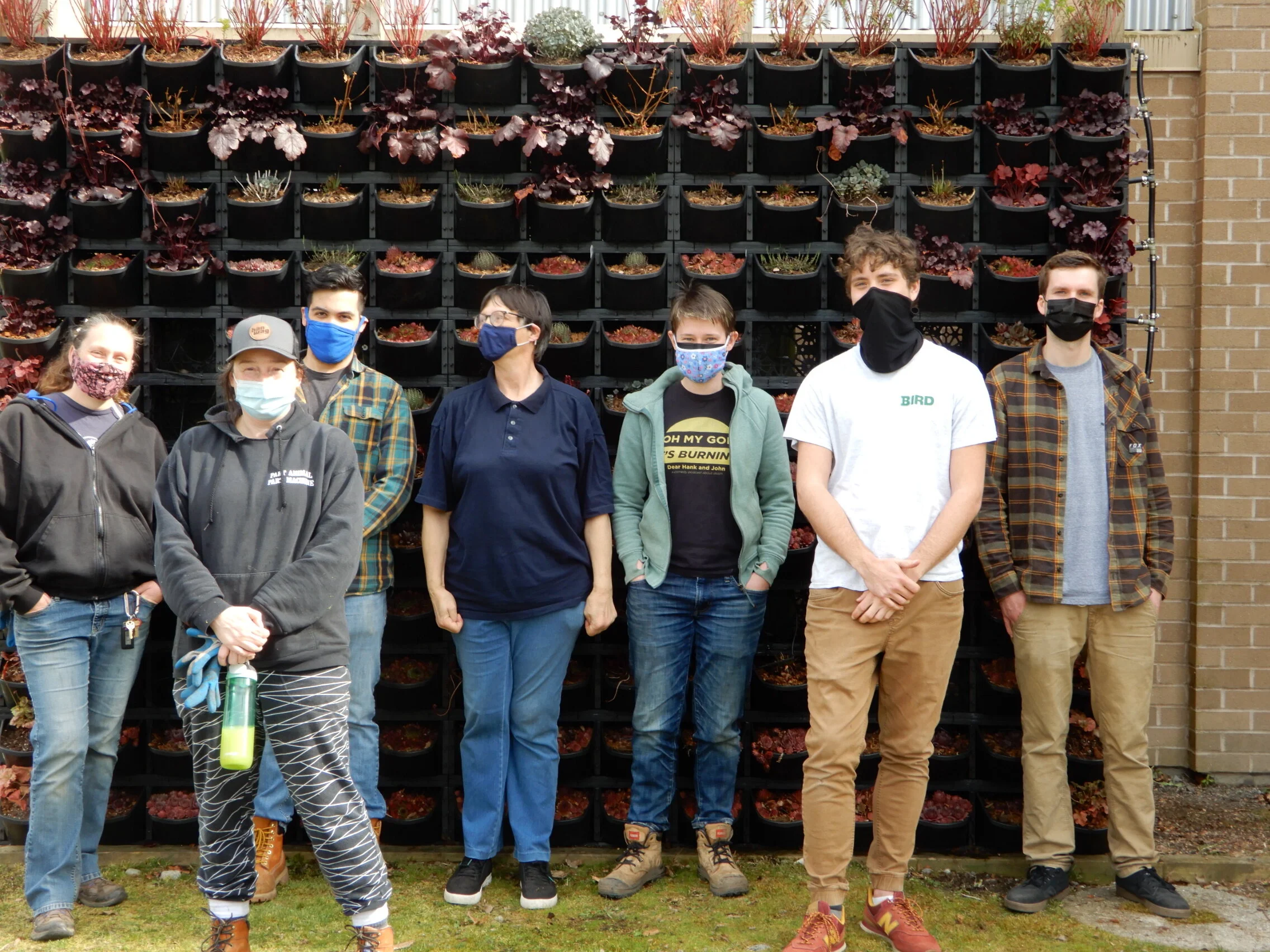Earth Laughs in Flowers: An Off-Grid Solar-Powered Vertical Rain Garden
Advertisement
“Where are these men? Asleep beneath their grounds:
And strangers, fond as they, their furrows plough.
Earth laughs in flowers, to see her boastful boys
Earth-proud, proud of the earth which is not theirs;
Who steer the plough, but cannot steer their feet
Clear of the grave.”
This project is located at the Kwantlen Polytechnic University Langley Campus, on the unceded lands of the Kwantlen First Nation in Langley, BC, Canada. The campus landscape plan was designed by the late Cornelia Hahn Oberlander in 1991, with applied work on decolonization and blue-green infrastructure undertaken as experiential learning projects since 2013 by KPU Bachelor of Horticulture Science Urban Ecosystems Major students under my supervision.
The wall in May 2015. Photo courtesy K. Dunster
The campus is entirely located mid-watershed on the floodplain of Logan Creek, a salmon-bearing stream that flows into the Nicomekl River and onwards to Boundary Bay and the Salish Sea.
We began in 2014 with a full campus audit of impermeable surfaces and calculation of runoff volumes being sent directly into the stormwater system. We calculated that 23 million litres of precipitation was being displaced, diverted, and discharged into the stormwater system, essentially starving the floodplain and creek of much-needed base water to maintain water levels for fish and other aquatic species.
From this data driven research, we made plans to design and implement a suite of interconnected blue-green infrastructure projects that include ecosystem repair of the floodplain from 150 years of colonial-settler agriculture related abuse. The vertical rain garden, a 75-metre rain garden, a 575 square metre living roof with permanent habitat including a wetland, fruit tree orchard, food production beds, and space for student projects and field testing of next-gen roof plants for south-coastal BC all function as stand-alone projects. Yet they all work synergistically to improve rainwater management and biodiversity on campus.
The vertical rain garden was designed and installed in the 12-week Spring semester of 2015 keeping six guiding principles in mind:
Water is intercepted from the downspouts that drain small sloping metal roofs. Photo courtesy K. Dunster
Water is a valuable resource necessary for human life, health, and well-being.
Wetlands and riparian ecosystems provide many ecosystem services in urban areas.
Hydrological and ecological functions were disrupted when the KPU Langley campus was located on a wetland within the 200-year floodplain of Logan Creek.
Integrating storm water runoff into the campus landscape design helps maximize ecosystem services to the campus and reduces flooding in areas where the water table is at or above ground level.
Capturing and storing the frequent rainfall events from a small roof and using the excess water to irrigate a vertical living wall using off-grid technology and plants growing in soil are good and sustainable horticultural practices.
Designing with rainwater in ways that are visible, creative, and accessible can connect people to nature, and create a tool for urban ecosystem awareness.
Advertisement
Most water intercepted on KPU Langley roofs drains to the internal plumbing system designed by DA Architects + Planners. However, we located a few external downspouts collecting water from small sloping metal roofs. The wall selected is west facing, next to a downspout that annually discharges about 48,000 litres of rainwater from a metal roof above a 33 square metre office space.
Key Features
Atlantis Gro-Wall Kits. Photo Courtesy: Atlantis
10 Atlantis Gro-Wall kits, a soil-based wall system developed in Australia. The system we used has 18 plant bins per kit for a total of 180 plants, and each bin holds about 2 litres of soil. The wall space available allowed for a configuration of 12 bins vertically (2.46 m total height) by 15 bins across (3.4 m).
The beauty of a soil-based system is that the specific soil requirements of individual species can be accommodated through custom blends and in 2015 our initial intent was to trial many different plants to monitor survival and learn more about how to make an outdoor green wall system work.
A cistern collects roof runoff, which is used to irrigate the green wall. Photo courtesy K. Dunster
After five years of trialing plants, we concluded that sudden and occasional West Coast winter frosts and freezing winds were more likely to kill plants than summer droughts if the wall gets some water during the summer. We custom-designed a breathable blanket that will be installed quickly in winter 2021 to cover the wall when the forecast is for sub-zero temperatures. The blanket protects the plants from the freezing temperatures and helps to ensure their survival.
From the beginning the idea was to create a vertical rain garden to divert roof runoff from the stormwater system. To do this we installed a Bushman BSLT530e collection tank behind the wall and diverted the downspout into the 2,000 litre tank. Because the roof can shed 48,000 litres in a year, we installed an overflow pipe to allow excess water to spill onto and infiltrate the ground. A future class will be playing with a long-simmering idea to divert the excess water into a wet-rice paddy and grow a more useful edible grass than the existing turf.
Solar panel used to drive irrigation pump for rainwater captured to be used on green wall. Photo courtesy K. Dunster
Back in 2015 the students in HORT 3251 Landscape + Environment (our blue-green infrastructure course) installed 75 metres of 13mm flexible irrigation pipe with individual inline drip emitters to each bin but relied on direct precipitation or hand-watered during the summer droughts for 5 years.
In Spring 2021 HORT 3251 finally took the vertical rain garden off-grid and installed a Renogy 50-watt monocrystalline solar panel to directly power a Seaflo 12V 3.0 GPM (11.3 LPM) pump to run the irrigation system. For back-up power we also installed a Canadian Tire Motomaster 12-Volt 32 Ah Group Size U1 SLA battery supplied by Canadian Tire. The pump will likely only be running for up to 2 hours per week during the summer drought and with a 32Ah battery we will have more than 2 days run time without having to be charged (storage for super cloudy rainy days – even in summer).
The system currently runs on a timer 3 times a week for 5 minutes (180 litres per week) which has been ample to keep the soil in each plant bin moist during the spring, without draining the tank when it stops raining. As the summer drought progresses, we will be increasing the watering to keep the plants happy. We will be experimenting with irrigation frequency and duration. After years of research on different plants the 2020 class began a complete re-planting only to be stopped by the COVID-19 pandemic. Plants were selected for cold-hardiness and drought-tolerance, a dark maroon colour palette, and nectar production. The 180 plants were then held for root establishment in a polyhouse through the 2020 lockdown with a few failures that were replaced in 2021 prior to reinstalling in the green wall.
Advertisement
The cistern, battery, and other components behind the green wall. Photo courtesy K. Dunster
The vertical rain garden is accessible for visits when the sun is shining, and we will be designing and installing interpretive signage to fit on the side door panels in Fall 2021.
Plant List (2021)
Armeria pseudarmeria 'Ballerina Red'
Dianthus deltoides 'Flashing Lights'
Euphorbia x martinii `Rudolph'
Fuchsia magellanica ‘Riccartonii’
Haworthia fasciata
Heuchera ‘Northern Exposure Red’
Heuchera ‘Obsidian’
Heuchera ‘Plum Pudding’
Sempervivum ‘Kalinda’
Sempervivum ‘Royal Ruby’
Sempervivum ‘Sunset’
The class of 2021. Photo courtesy K. Dunster
Dr. Kathy Dunster is a registered landscape architect (MBCSLA) and a registered professional biologist (RPBio) in BC and a registered member of the Canadian Society of Landscape Architects. Since 1987 her professional practice has focused on numerous projects that address the inventory, planning, conservation, and management of natural and cultural landscapes, ecosystem restoration, and integrated ecological landscape design at many different scales.
See more images from the project at the KPU Urban Ecosystems Major - Bachelor of Hort Science’s Facebook Album








